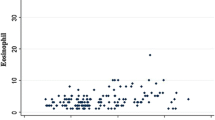Abstract
Allergic rhinitis (AR) is a chronic inflammatory disease induced by IgE mediated reaction and identified clinically by presence of nasal discharge, sneezing, itching and nasal congestion. Aim of this study was to determine Serum IgE level which is an important indicator of AR. To analyse the diagnostic significance of serum IgE level and their pharmacoeconomic status in the management of AR with commonly used antihistaminic. Estimation of serum IgE can serve as a simple and reliable investigative tool in the diagnostic and management of AR. Fifty two adult patient with history of allergic rhinitis were randomly divided into four study groups and administered either Cetirizine, Levocetirizine, Loratidine or Fexofenadine respectively for one week. Blood samples were analysed to determine serum IgE level and the results were subjected to statistical analysis. The mean value and standard deviation were obtained and tabulated using paired t test. A total 52 patient were divided into four group, 13 in each group of age between 18 and 65 years (mean age 33.73 ± 10.23 years); 48.08% females and 51.92% male were randomized. Mean compliance with treatment was 100% for all study groups. The mean serum IgE level was significantly reduced in Levocetirizine as compared to Cetirizine, Loratidine and Fexofenadine groups. Levocetirizine controls the symptoms of AR better as compared to Cetirizine, Loratidine and Fexofenadine and is a better choice due to its cost effectiveness, tolerability and safety profile.
Similar content being viewed by others
References
Varlato G, Corsico A, Villani S (2003) Is the prevalence of adult asthma and allergic rhinitis still increasing? Results of an Italian study. J Allergy Clin Immunol 111(6):1232–1238
Dykewicz MS, Finman S (1998) Executive summary of joint task force practice parameters on diagnosis and management of rhinitis. Ann Allergy Asthma Immunol 81:463–468
Bauchau V, Durham SR (2005) Epidemiological characterization of the intermittent and persistent types of allergic rhinitis. Allergy 60:350–353
Bousquet J, Khaltaev N, Cruz AA (2008) Allergic Rhinitis and its Impact on Asthma (ARIA) 2008 Update (in collaboration with the World Health Organization). Allergy 63(suppl.86):8–160
Baraniuk JN (1997) Pathogenesis of allergic rhinitis. J Allergy Clin Immunol 99(2):763–772
Ishizaka K, Ishizaka T, Hornbrook MM (1996) Physiochemical properties of reaginic antibody. Correlation with reaginic activity with gamma-E-globulin antibody. J Immunol 97:840–853
Palomares O, Alkdis M, Martin- Fontecha M, Alkdis CA (2017) Mechanism of immune regulation in allergic disease: the role of regulatory T and B cells. Immunol Rev 278:219–236
Abramson J, Petch I (2007) Regulkation of mast cell response to the type I Fcε receptor. Immunol Rev 217:231–235
Corsico AG et al (2017) Allergen specific immunoglobulin E and allergic rhinitis severity. Allergy Rhinol 8(1):e1–e4
Thwaits R, Townsend JR (1998) Pharmaco-economics in the new millennium: a pharmaceutical industry perspective. Pharmacoeconomics 13(2):175–180
Plebani M, Bernardi D, Basso D, Faggian D et al (1998) Measurement of specific immunoglobulin E: intermethod comparison and standardization. Clinchem 9:44
Homerger HA, Yuninger JW (1983) Laboratory testing in the diagnosis and management of allergic disease. Clin Lab 2:351–388
Lopert R, Lang DL (2003) Use of pharmacoeconomic in prescribing research. Part 3: cost effectiveness analysis—a technique for decision making at the margin. J Clin Pharm Ther 28:243–249
Moseges R, Konig V, Koberlein J (2013) The effectiveness of modern antihistaminics for the treatment of allergic rhinitis—an IPD meta-analysis of 140853 pateints. Allergol Int 62(2):215–222
Ciprandi G, Cirillo I, Vizzaccaro A, Tosca MA (2004) Levoceririze improves nasal obstruction and modulates cytokine pattern in patients with seasonal allergic rhinitis: a pilot study. Clin exp allergy 34(6):958–964
Horak F, Zieglmayer PU et al (2005) Levocetirizine has a longer duration of action on improving total nasal symptoms score than fexofenadine after single administration. Br J Clin Pharmacol 60(1):31–34
Stubner P, Zieglmayer HF (2004) A direct comparison of the efficacy of antihistaminics in SAR and PAR: the Vienna Challenge Chamber (VCC). Curr Med Res Opin 20(6):891–902
Dubaaske LM, Seal B, Brown MC (2008) Pharamacoeconomics of Levocetirizine in allergic rhinitis and chronic idiopathic urticaria: consideration for the USA. Expert Rev Pharmacoecon Outcomes Res 8(3):233–241
Rogkakou A et al (2011) Persistent allergic rhinitis and the XPERT study. World Allergy Organ J 4(3):S32
Acknowledgements
Authors would like to thank department of ENT for allowing them to conduct study, also would like to thank Mrs. Raje Swati, Assistant Professor, Department of Community Medicine for data analysis and valuable guidance during the development of this manuscript and provide valuable input for statistical and pharmacoeconomic analysis.
Funding
This study was not financially supported from external sources.
Author information
Authors and Affiliations
Corresponding author
Ethics declarations
Conflict of interest
None declared.
Ethical Approval
The study was approved by the Institutional Ethical Committee.
Additional information
Publisher's Note
Springer Nature remains neutral with regard to jurisdictional claims in published maps and institutional affiliations.
Rights and permissions
Springer Nature or its licensor (e.g. a society or other partner) holds exclusive rights to this article under a publishing agreement with the author(s) or other rightsholder(s); author self-archiving of the accepted manuscript version of this article is solely governed by the terms of such publishing agreement and applicable law.
About this article
Cite this article
Pentewar, G.S., Parab, S.R. Pharmacoeconomic Assessment of Antiallergic Drugs by Comparing Serum Immunoglobulin E Level as a Diagnostic and Monitoring Indicator of Allergic Rhinitis in Rural Population of India. Indian J Otolaryngol Head Neck Surg 75 (Suppl 1), 928–933 (2023). https://doi.org/10.1007/s12070-023-03488-9
Received:
Accepted:
Published:
Issue Date:
DOI: https://doi.org/10.1007/s12070-023-03488-9




